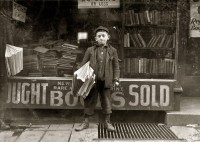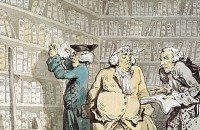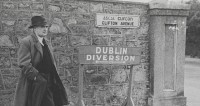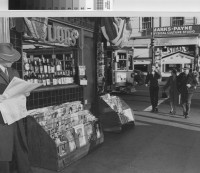The Lawbook Exchange just issued an E-List: Blackstone: 30 Items, inspired by the recent publication of Ann J. Laeuchli's Bibliographical Catalog of William Blackstone. Lowry-James Rare Prints & Books announced the publication of Catalogue Number Ten: Charles Livingston Bull. Joslin Hall Rare Books released Catalog #351: A Selection of Jane Yolen's Signed Poetry Broadsides and Catalog 352 - A Selection of Books & Ephemera for October. Margolis & Moss offers a list of 48 Portfolios of Prints, Photographs, Private Press Books, and Multiples. Rulon-Miller Books has a short list of recent acquisitions. Quill & Brush is offering a comprehensive collection of Eudora Welty material. Jeff Maser's latest arrivals include a collection of works by Simon Cutts among other interesting material. Kaaterskill Books published Catalogue 19: Latin Americana, which features works dating from the early 18th century to the end of the last century. Walkabout Books' latest Catalogue 3: An American Miscellany is available in digital and print formats. J & J Lubrano Music Antiquarians published their latest catalogue, The Collection of Jacob Lateiner Part 1: Beethoven First and Early Editions, and announced the availability of The Robert H. and Jaqueline M. Cowden Collection of Books Relating to Concert and Opera Singers. Thorn Books issued their Fall List of over 60 new items. Bolerium Books has a new catalogue out on Indigenous Activism and History in North America. James S. Jaffe Rare Books' new ca... [more October Catalogue and List Announcements]
ILAB is coordinating a series of Pop-Up Book Fairs across the world for UNESCO World Book and Copyright Day on April 23, 2015. The two organizations have created an offiial partnership for the event and ILAB is asking as many members as possible to organize and attend as many pop-up fairs as possible. Former President of the ABA Laurence Worms describes the envisioned pop-ups: “Some booksellers, some books, some tables and a big sign. Just liaise with ILAB on the publicity. No-one has to travel far or be away from base for too long. They can last all day or just an hour or two. Imagination and invention are the only limitations.” For more information, contact ILAB Committee Member Sally Burdon. Bridwell Library is pleased to announce the opening of two exhibitions on site and online this fall. "Welcome Additions" highlights fifty rare books, manuscripts, broadsides, prints, and letters that were acquired by Bridwell Library Special Collections between 2008 and 2014. It is open through December 12th. "Missionary Presses" highlights Bibles and other religious texts in indigenous languages published by missionary presses in the nineteenth century. It is open through December 5th. The digital exhibitions will continue to remain accessible after the exhibitions in the library have closed. Bernard Quaritch Ltd recently published a new book by Arthur Freeman entitled Bibliotheca Fictiva. It is an inventory of books and manuscripts relating to literary forgery. Click here for mor... [more Endnotes: Rare Books News & Events]
Rock Toews (Back Creek Books LLC) is a key player in determining whether a Maryland area slated for development was the site of a Civil War parole camp. Priscilla Juvelis contributed a chapter to an upcoming book on William T. Vollmann entitled William T. Volmann: A Critical Companion. Don Lindgren of Rabelais Inc. is interviewed for Eater's piece on 72 Ways Food Can Change the World. He is in good company with Alice Waters, Jose Andres, and Danny Meyer, to name a few of the other interviewees. An interview with Leonard Fox on fashion illustration appeared in the September issue of Traditional Home magazine. Kevin Mac Donnell contributed the third chapter to the recently published Collecting, Curating and Researching Writer's Libraries, A Handbook edited by Richard Oram and Joseph Nicholson (Rowman & Littlefield, 2014). An excerpt was posted on The New Antiquarian and you can read the article in its entirety in our Member Articles section. If you are interested in purchasing the book, please note the promotional code. [more New Antiquarians in the News]
To mark the 75th Anniversary of 1939, we've asked some ABAA members to discuss publications from that momentous year. Garrett Scott, a prominent Ann Arbor bookseller, offers a divagation upon At Swim-Two-Birds, Flann O'Brien's proto-post-modern first book– published in 1939. Biographical reminiscence, part the first: Sometime in 1991, I had taken up temporary residence in a storage closet in a university-owned cooperative house. This was during a period in college in which I was neither enrolled in any classes nor strictly speaking in the eyes of the university a resident of the university-owned cooperative house. The storage closet was situated within one easy extension-cord's length of a hallway electrical outlet and thus easily outfitted with a small fan and a reading lamp and a clock radio. A spare mattress fit neatly between the stacks of cardboard boxes and assorted lumber. The storage closet had the added utility of providing my then-girlfriend with a place to lodge me when she sought respite from my company. One evening prior to another bout of rustication she endeavored to occupy me by handing me a paperback copy of a book written by a man named Flann O'Brien, a member of the Irish nation. The name of the book was At Swim-Two-Birds. She told me the book was about a college student trying to write a book. Nature of her summary: Perfunctory. The figure of speech she had inadvertently employed: Understatement. And thus with nothing but the hum of the fan beside my mat... [more 1939: At Swim-Two-Birds]
We asked Michael Hackenberg, Chair of the Northern California Book Fair Committee, to provide his personal perspective on the decision to move the ABAA-sponsored California International Antiquarian Book Fair from San Francisco to Oakland. (Our California fairs alternate between Southern California and Northern California.) Knowing the Concourse was no more, the Book Fair Committee basically had two options (since the Yerba Buena Center and its big San Francisco downtown Marriott laughed at our small size): Fort Mason or the Oakland Marriott City Center. Site visits and many discussions led the Committee to select the Oakland location. It boasts a brightly lit and large exhibit hall with no dividing wall (and no leaking roof), easy self-loading and unloading, plus smooth arrangements for both EPI (our local union crew located on nearby Alameda and already very familiar with the venue) and Caladex (I personally walked through the venue with both of those firms' representatives, and they were quite pleased with the logistical situation). It has a quality hotel on-site with very advantageous room rates (the Committee looked over the rooms carefully). Its great East Bay location has three freeways joining at the Bay Bridge approach and an ample parking garage. There is a 12th Street BART stop right at the door, with direct connections from Millbrae on the SF Peninsula, Fremont, Richmond/Berkeley, and all the wealthy Bay Area suburbs on the back side of the East Bay hills (Walnut ... [more Across the Bay: ABAA California Fair Moves to Oakland]
The following is an excerpt from the third chapter of Collecting, Curating, And Researching Writers' Libraries, A Handbook, edited by Richard Oram and Joseph Nicholson (Rowman & Littlefield, 2014). This chapter deals with the role of the bookseller; other chapters deal with the roles of librarians, curators, and researchers, with accounts of some libraries, a list of authors' libraries preserved in public and private hands, and interviews conducted by Oram and MacDonnell with five well-known authors who describe candidly just how they organize and use their books. In this chapter MacDonnell outlines the five-stage process a bookseller employs when assessing a writer's library: defining what is in the library; assessing its salability; providing valuation; preparing the library for sale; and finally, negotiating its sale. The full article, as well as information on how to order a discounted copy, can be found here. III. The First Order of Business: Defining the Library A bookseller's first order of business when dealing with an author's library is defining just what comprises the author's library. This sounds simple, but books are often mixed with magazines and miscellaneous papers, and the day may soon be coming when an author might have more titles stored on his e-reader than on his shelves. An author might also have listened to audio books, now lurking on CDs or MP3s in some nearby device like a laptop, or iPhone, etc. Distinguishing an author's library from a “household�... [more Writers’ Libraries: The Bookseller’s Perspective]
As if the Islamic State of Iraq and the Levant's (ISIL; also referred to as IS, ISIS, and Daesh) actions weren't troubling enough, last week the US Department of State reported on the irrevocable damage the terror organization continues to wreak on cultural artifacts in Iraq and Syria. The destruction goes beyond wartime collateral damage– ISIL is celebrating their destruction of religious monuments and profiting from the systematic looting taking place. Corine Wegener, a cultural heritage preservationist at the Smithsonian Institution, called the current situation "one of the biggest problems to confront the cultural heritage community in decades." Secretary of State John Kerry joined Thomas Campbell, Director of the Metropolitan Museum of Art, in hosting a conference last week at the Met to call attention to the issue. Some remarks from Secretary of State Kerry: We gather in the midst of one of the most tragic and one of the most outrageous assaults on our shared heritage that perhaps any of us have seen in a lifetime. Ancient treasures in Iraq and in Syria have now become the casualties of continuing warfare and looting. And no one group has done more to put our shared cultural heritage in the gun sights than ISIL. ISIL is not only beheading individuals; it is tearing at the fabric of whole civilizations. It has no respect for life. It has no respect for religion. And it has no respect for culture, which for millions is actually the foundation of life...ISIL is stealing ... [more Destruction of Cultural Artifacts in Iraq and Syria]
Two weeks ago, I was in York for the inaugural York Antiquarian Book Seminar (a British equivalent of the highly successful Colorado Antiquarian Book Seminar). The whole experience was hugely invigorating. Here were 25 students, young and old, starting out in the rare book trade, full of promise, eagerness— and questions! One of the sessions I led was on cataloguing. For, as Roger Gaskell notes in his Terms of the Trade, "a large part of the trade in antiquarian books is conducted by catalogues, whether printed or online, and books offered in shops or at book fairs will usually be accompanied by a written description." It's those printed catalogues I want to talk about today. Earlier this year, Lorne Bair, on this very blog, waxed eloquently on the benefits of producing printed catalogues, and I agree with him wholeheartedly. People often ask me about my printed catalogues (six to date), so I thought I would share something of their history here. I set up on my own in January 2010, and right from the start I knew I wanted to do printed catalogues. I could have just sold books by e-mail, sending out PDF lists of what I have (and I do do that, too), but book collectors like books, physical objects that they can carry around, read on the bus, write comments on, mark by turning over the corner of a page. Because it is so easy now (and, of course, much cheaper) to create one's own catalogues, in Word or whatever with a few scans dropped in, that is what many booksellers do, but ... [more Catablog]
To mark the 75th Anniversary of 1939, we've asked some ABAA members to discuss publications from that momentous year. Marc Selvaggio, whose specialties include World's Fairs and International Expositions, takes us down memory lane as he examines the publications of the 1939 World's Fairs held in New York and San Francisco. On September 23rd, 1938, a group of men in dark suits gathered around a construction site in Queens and watched as a 90-inch, 800-pound cylinder, made of the special new alloy called “Cupaloy,” was lowered down a 500-foot tube. The solemn ceremony involved in the placement of this cylinder—officially known as the Westinghouse Time Capsule– inaugurated the site for the New York World's Fair. The Fair itself opened to an enthusiastic public on April 30, 1939. Meanwhile independent of the planning frenzy in New York, crews were busy creating a fabricated spit of land in the middle of the San Francisco Bay, a square 400-acre piece of artificial land-fill that would be romantically labeled, “Treasure Island.” Here, on February 18, 1939, the Golden Gate International Exposition was officially opened. Both Fairs would return in 1940, more to correct their balance books (ultimately, unsuccessfully) than for public demand. The Westinghouse Time Capsule contained what its creators considered “a complete record of our civilization”—a selection of fabrics, a fountain pen, seeds and metals, a slide rule, Barney Google comics, microfilm of hundreds of b... [more 1939: Before The War, The Fairs]
This item is still missing as of 5/29/2019. The following item has been reported stolen from a personal library in Texas: Lady Chatterley's Lover by D.H. Lawrence First Edition. Signed and numbered, No 249. If you have any information reagding this item, please contact Shannon Dorsey at (512) 922-2185 or shannonrose.dorsey@gmail.com. [more Stolen: Signed First Edition of ‘Lady Chatterley’s Lover’]










